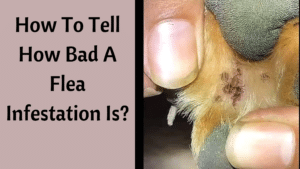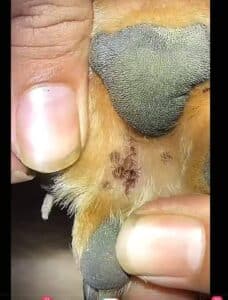I love watching my dogs running around outdoors, playing, and generally getting into harmless mischief; they particularly enjoy a game of fetch. However, if you are a pet owner, then you understand the real worry that your furry friends can bring fleas indoors.
Imagine eagerly anticipating cuddling with your pet after a long day, only for you to start scratching yourself because your furry friend brought fleas inside.
Now the question is, are you dealing with one or two fleas or a much larger issue? Continue reading to discover how to tell how bad a flea infestation is.
How To Tell How Bad A Flea Infestation Is In Your Home
You do not have to pull out a flea comb or use a magnifying glass to know you have fleas in your home. However, you want to learn of their presence before they multiply and fill the hard-to-reach places, making eliminating them more cumbersome.
So, how to tell how bad a flea infestation is?
1. Monitor Flea Bites on Humans
If a flea has ever bitten you, you know how unbearable the itching can be. Your lower body parts, like the feet, calves, ankles, knees, legs, and folds, are significantly more vulnerable to flea bites.
The bites typically appear as small (smaller than mosquito bites), raised bumps with a red halo around them, and often appear in clusters or lines.
Related Posts:
- How to get rid of fleas on cats
- How to get rid of fleas in house
- How Long Does It Take For Bleach To Kill Fleas?
Your sensitivity to flea bites will determine how you react to them. For instance, you may experience mild itching and redness or develop more severe reactions, including blistering, hives, or a rash.
If you and other members of your household get bitten by fleas frequently, it is a major indicator of a significant flea population.
2. Observe Your Pets
Look for excessive scratching, biting, or chewing, especially around the neck, tail, and groin areas. Check for flea dirt (dark, pepper-like specks) on their fur, which is actually flea feces.
Read More: Is My Dog Allergic to Fleas?
3. Check Your Home for Flea Dirt
Fleas can leave behind tiny black or red-brown specks around your house or on your pets. However, be careful because it could just be dust or dirt, but if it shows brown or red hues, if you spray it with water, you are probably dealing with flea dirt.
So, you’ve determined that it is flea dirt and not ordinary dirt, but how much is it, and how does it indicate the severity of the infestation? The flea dirt quantity and frequency will help you do so. A large amount of flea dirt indicates a significant infestation.
In addition, regularly finding fresh flea dirt indicates an ongoing infestation.
The white sock test will help you determine the presence of fleas or flea eggs in an area. Here is how to perform this test:
Put on a pair of white socks, preferably knee-high or calf-length, to cover your lower legs and ankles.
Walk slowly and deliberately in areas where you suspect flea activity, such as your pet’s resting areas, carpets, or areas where you have noticed flea dirt.
After a few minutes of walking, remove the socks and scrutinize them. Look for tiny black specks, which could be flea dirt or fleas. Fleas are small, reddish-brown insects, about 1 to 3 mm long.
4. Flea Eggs
You can uncover valuable information on how bad a flea infestation you have on your hands by the flea eggs. For instance, if you find flea eggs in abundance in areas such as pet bedding, carpets, or furniture, fleas are reproducing and infesting those locations. Flea eggs are so tiny that you require a magnifying glass to see them.
5. Hair Loss
Don’t get me wrong, hair loss in pets can be caused by different things, including underlying health conditions, allergies, skin infections, and hormonal imbalances. However, you may also be dealing with a flea infestation.
As your pet scratches or chews its skin to relieve the discomfort caused by fleas, it can lead to visible hair loss. In addition, if your pet suffers from flea allergy dermatitis, flea bites trigger an intense allergic reaction, leading to excessive itching, scratching, and hair loss.
Remember that intense itching, significant hair loss, and self-trauma are indicative of a large infestation.
6. Pale Pet Gums
Are the gums of your pets pale, and are the animals more lethargic than usual? Fleas consume pet blood, putting them at risk of anemia hence the tiredness and pale skin.
However, for your pets to suffer from anemia due to fleas, these insects must consume a substantial amount of blood from them, which happens in a severe infestation.
Apart from pale gums, you may also notice rapid breathing, weight loss, decreased appetite, and, in extreme cases, difficulty walking or collapsing.
7. Restless Pets
Is your otherwise friendly, calm, playful pet suddenly fidgety and snappy? This is a common reaction to fleas since they cannot tell you they have a problem or can they remedy it themselves.
You know your pet better than anyone else, so act as soon as you realize a change in their behavior.
What Causes Flea Infestation?
It is normal to want to know why you have fleas in your home. So here are the common causes:
1. Pets
Do you often let your pets spend time outdoors or come into contact with other animals? This is the first place to look when you find fleas in your home.
Pets often carry fleas on their bodies from outside and easily spread them throughout your house, including bedding, carpets, and furniture.
2. Wildlife
So, you do not have pets or have already ruled them out as the cause of the flea infestation. In that case, consider wild animals like squirrels, raccoons, or mice because they can bring fleas to your vicinity, leaving eggs, larvae, or adult fleas in your yard.
3. Previous Infestations
Residual flea eggs, pupae, or larvae hiding in carpets, bedding, or upholstery from a past infestation can develop into adult fleas and cause a new infestation.
4. Shared Spaces
Does your home or apartment building has shared spaces such as hallways, common areas, or adjoining walls? A flea problem from your neighbor can spread to your living space.
5. Outdoor Environments
Expect an encounter with fleas and possibly an infestation if you live in warm and humid environments.
6. Human Interaction
This may be rare, but fleas can bite you, facilitating their movement from one place to another. Therefore, fleas can attach to your clothing or skin if you come into contact with an infested animal or visit an infested area.
How Do You Get Rid Of A Severe Flea Infestation?
So we now know the causes of flea infestation and how to determine its severity. What’s left is to eliminate them. For the best results, address the fleas on your pets and your surrounding.
a) Treat Your Pets
Your vet is better positioned to recommend the appropriate flea control products for your pets, so seek their guidance. You will likely use topical treatments, oral medications, or flea collars to kill the fleas. Follow the veterinarian’s instructions regarding dosage, frequency, and application, and treat all your pets simultaneously.
b) Clean and Vacuum
Once your pets are clean and free of fleas, it is time to tackle the house. So, vacuum all carpeted areas, rugs, upholstery, and pet bedding to remove adult fleas, eggs, larvae, and pupae, paying particular attention to areas your pets spend a lot of time. Immediately empty the vacuum bag or clean the canister after vacuuming to prevent live fleas from reinfesting your home.
Do not forget to launder your pets’ bedding, blankets, and other washable items in hot water to kill flea eggs, larvae, and adult fleas. Use a high-temperature setting in the dryer or let them dry in the sun.
I would also recommend using flea-killing sprays or powders on bedding, furniture, and carpets to help eliminate fleas.
c)Treat the Environment
Spray your home with an insecticide or spread diatomaceous earth to kill thr fleas in your home. Ensure the treatment gets to the thin cracks or gaps in your furniture, bed, and floor. Furthermore, treat your yard too if your pets spend time outdoors.
A natural, pet-safe flea repellent will help you eliminate the fleas in your yard. Also, mow your lawn, remove debris, and regularly clean your pets’ outdoor accessories, such as food bowls, dog houses, and toys.
Prevent Future Infestations
After a thorough job, you have successfully eliminated flea infestation. Your next duty is to prevent future infestation. This entails using veterinary-approved flea preventatives on your pets to keep fleas at bay.
In addition, maintain a clean living environment by regularly vacuuming, washing pet bedding, and keeping your home tidy. Furthermore, if you bring a new pet into your home, ensure they are properly treated for fleas before introducing them to your other pets.
Conclusion
A flea infestation may be inevitable, especially if you have pets that spend time outside or with other animals. However, you don’t have to share your home with these parasites when you can effectively get rid of them and even prevent their infestation. Just make sure you tackle the fleas on your pets inside the house and in the yard.

I’m Mike Hyle, an exterminator with 7+ years of experience handling all sorts of pests, including mice, cockroaches, bed bugs, and termites. I also write for Pest Solutions DIY blog to share my knowledge and help homeowners keep their homes pest-free. Outside work, I enjoy hunting, snowshoeing, and exploring nature. Check out my blog for helpful pest control tips!


